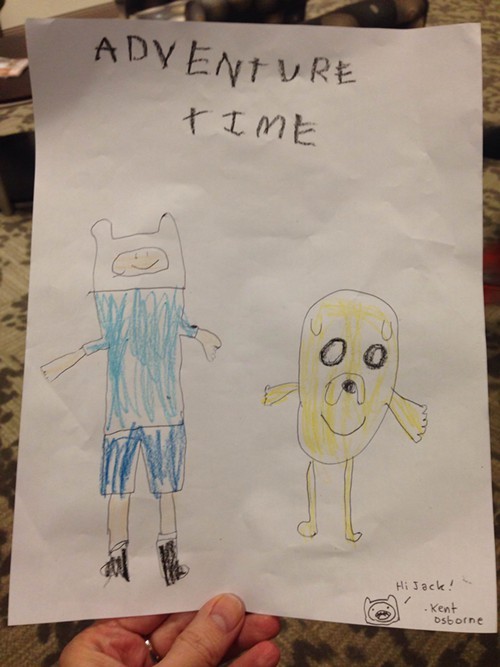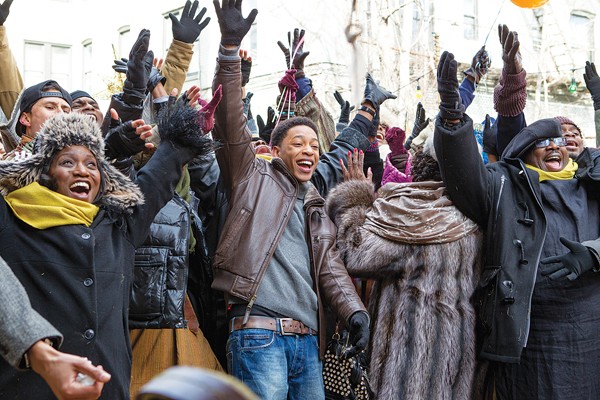Thursday, Sept. 26
Gonerfest traditionally opens with a low-key, outdoor show at the gazebo at the corner of Cooper and Young. This year, however, the opening promises to be a lot less low key, with Japanese legends Guitar Wolf bringing their brand of acrobatic, primal, ultra-high-energy garage primitivism to the neighborhood that is not aware of what is about to hit it.
The first night of Gonerfest 10 opens at the Hi-Tone with the Blind Shake, a Minneapolis three-piece in the noisy Hüsker Dü tradition, whose fantastic second full-length album Key To A False Door just dropped. Next up is the confusingly named Octa#Grape, a sort-of San Diego supergroup led by former Trumans Water noisemeister Glen Galloway, and then the reverb-drenched Frenchmen Catholic Spray. Detroit’s Tyvek plays straight-ahead, pogo-worthy punk appropriate to their hometown’s reputation. Their previous Gonerfest sets have been pits of riotous energy. The first Memphis band on the bill is Ex-Cult, who played one of their earliest shows at last year’s Gonerfest and have since gathered a following by barnstorming the nation supporting Ty Segall. Closing the first night is New Orleans’ organ wizard Quintron, whose headlining set at Gonerfest 6, which wound up a tired bunch of punks into a giant, all-night dance party — as Eric Friedl says, “It was a big, sweaty mess” — and is on the shortlist for best Gonerfest performance ever.
Friday, Sept. 27
Friday kicks off with an afternoon show at the Buccaneer featuring the ramshackle Florida rock of Gino and the Goons and poppy Swedes The Martin Savage Gang.
The Hi-Tone show begins with a trio of Tennessee’s finest. Fronted by Memphis noise rock legend Richard Martin and including Friedl, the indescribable True Sons of Thunder must be seen to be believed. (“We don’t know what we’re doing, but we’ve been doing it for 8 years, so we must be doing something right,” Martin says.) Viva L’American Death Ray Music marks a rare appearance from a pair of Memphis’ favorite sons, Nick Diablo and Harlan T. Bobo, who have decamped to Brooklyn and France, respectively. Nashville’s Cheap Time are Gonerfest veterans with deep Memphis roots and solid, assured songwriting by leader Jeffery Novak.
The first of two Seattle bands at the fest is Head, a favorite of Goner’s Zac Ives. Detroit’s Human Eye, led by Detroit’s Timmy Vulgar, brings their psychedelic blacklight stage show and sci-fi weirdness back to the Gonerfest stage, where they dominated two years ago.
The big story of the tenth Gonerfest is Friday night’s headliner. “Mudhoney is by far the biggest band we’ve ever had play,” Ives says. The Seattle band was there at the conception of the ’80s “Seattle sound,” and their first single, “Touch Me I’m Sick” marked, if not the beginning of the grunge era, then at least the first time most people outside the Pacific Northwest heard the sound that turned rock-and-roll inside out and made the former underground the mainstream. They were labelmates on Sub Pop with Nirvana, and Mudhoney just released their tenth album, Vanishing Point, on the venerable label. In 1998, they recorded the album Tomorrow Hit Today under the tutelage of the late, legendary Memphis producer Jim Dickinson. Where others from that era either flamed out like Nirvana or went arena rock like Pearl Jam, Mudhoney has stuck to its guns, keeping the tempos up and the lyrics snotty. Many, if not most, of the bands playing at Gonerfest owe a stylistic debt to Mudhoney, whether they know it or not.
Saturday, Sept. 28
Gonerfest Saturday afternoons are in many ways the heart and soul of the festival. The festival invades Murphy’s in Midtown with 10 bands alternating on two stages, one inside and the other in the parking lot.
“That’s one of the shows that people from Memphis usually come to,” Ives says.
“It’s a good way to check out Gonerfest without the whole ‘subway ride to hell’ thing,” Friedl adds.
This year’s Saturday includes sets from Memphis punk provacateurs Manatees and Harlan T. Bobo’s newest project, the hard-rocking Fuzz. Other highlights include Gonerfest stalwarts Digital Leather, a synth-punk project by former Jay Reatard collaborator Shawn Foree; Oxford’s Talbot Adams; and Austin art-punks Spray Paint. Closing the afternoon show is Wreckless Eric, a British punk rocker who was there at the creation of the sound in 1977, and whose long and varied career has seen at least 17 albums under many different names and has taken him all over the world.
For those who have survived the preceeding two days, Saturday night at the Hi-Tone is stacked with talent. The night kicks off with the spacey, soulful sounds of Iowa’s Autodramatics and ’90s Australian punkers Onyas, featuring guitar strangler John “Mad” Macka, will throw down before Memphis’ own Msr. Jeffrey Evans leads his CC Riders out of retirement. Next up are Alabama synth weirdos Wizzard Sleeve, who are Gonerfest vets and perennial Memphis favorites. The penultimate band is Destruction Unit, led by former Memphian Ryan Russo. “They are one of the best bands on the planet,” Friedl says. “They’ve got this kind of Hawkwind thing going on, with everyone flying around the stage for 45 minutes.”
Saturday night’s headliners are the Australian gut bucket rock legends the Cosmic Psychos. The highly influential band’s first three records, Down on the Farm (1985), Cosmic Psychos (1987), and Go the Hack (1989), have been rereleased on Goner Records, and the band is currently touring America. The documentary film Blokes You Can Trust, about the band’s origins as Australian farmers and the startling contrast between life on the farm and life on the road.
“It’s not just about the music. If you like good documentaries, you’ll love this movie,” says Friedl.
The film is screening five times during Gonerfest, and is a must-see, not only as an introduction to the bands long legacy but also because it’s a great, funny, and endearing film where you’ll find out that when, on the song “Down On The Farm,” Ross Knight sings “I love my tractor!” he really means it. The Psychos fun, down-to-earth, no nonsense rock-and-roll will be the perfect capper to a stacked Gonerfest lineup.







